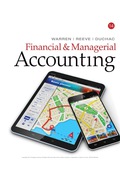
A.
Bonds Payable: Bonds payable are referred to long-term debts of the business, issued to various lenders known as bondholders, generally in multiples of $1,000 per bond, to raise fund for financing the operations.
Premium on bonds payable: It occurs when the bonds are issued at a high price than the face value.
Effective-interest method of amortization: It is an amortization model that apportions the amount of bond discount or premium based on the market interest rate.
Present Value: The value of today’s amount expected to be paid or received in the future at a compound interest rate is called as present value.
To calculate: The amount of cash proceeds (present value) from the sale of the bonds.
B.
To calculate: The amount of premium to be amortized for the first semiannual interest payment period.
C.
To calculate: The amount of premium to be amortized for the second semiannual interest payment period.
D.
The amount of bond interest expense for first year.
Want to see the full answer?
Check out a sample textbook solution
Chapter 11 Solutions
Financial & Managerial Accounting
- Bullock Enterprises buys equipment for $63,000 with a salvage value of $6,000 and an expected useful life of 7 years. What is the annual depreciation expense using the straight-line method?arrow_forwardI need assistance with this general accounting question using appropriate principles.arrow_forwardThe financial statements of the Wildhorse Manufacturing Supply Company report net credit sales of $360000 and net accounts receivable of $50400 and $36000 at the beginning of the year and the end of the year, respectively. What is the average collection period for accounts receivable in days? (Use 365 days for calculation.) A. 43.8 B. 33.6 C. 53.9 D. 84.3arrow_forward
- Use the accounting equation to determine the value of capitalarrow_forwardA purchase commitment represents a What? A. An option to purchase B. A contingent asset C. A sale on credit D. A firm order to buy MCQarrow_forwardMercury Ltd. has a debt-to-equity ratio of 0.60. Its total shareholders' equity is $3 million, and current liabilities total $950,000. How much long-term debt is outstanding? A. $500,000 B. $800,000 C. $850,000 D. $250,000arrow_forward
- Approximately how much of every retail sales dollar is made up of merchandise costarrow_forwardQuestion: Accounting - TJ's has annual sales of $813,200, total debt of $171,000, total equity of $396,000, and a profit margin of 5.78 percent. What is the return on assets? A) 8.29 percent B) 6.48 percent C) 9.94 percent D) 7.78 percent E) 8.02 percent HELParrow_forwardAnswer please general accountingarrow_forward
- help his answerarrow_forwardThe following credit sales are budgeted by Windsor Discount Retail Company: January $287600 February 423000 March 592200 April 507600 The company's past experience indicates that 70% of the accounts receivable are collected in the month of sale, 20% in the month following the sale, and 8% in the second month following the sale. The anticipated cash inflow for the month of March is $497440. $507600. C$522148. $473760.arrow_forwardThe fixed overhead deferred in ending inventory is?arrow_forward

 AccountingAccountingISBN:9781337272094Author:WARREN, Carl S., Reeve, James M., Duchac, Jonathan E.Publisher:Cengage Learning,
AccountingAccountingISBN:9781337272094Author:WARREN, Carl S., Reeve, James M., Duchac, Jonathan E.Publisher:Cengage Learning, Accounting Information SystemsAccountingISBN:9781337619202Author:Hall, James A.Publisher:Cengage Learning,
Accounting Information SystemsAccountingISBN:9781337619202Author:Hall, James A.Publisher:Cengage Learning, Horngren's Cost Accounting: A Managerial Emphasis...AccountingISBN:9780134475585Author:Srikant M. Datar, Madhav V. RajanPublisher:PEARSON
Horngren's Cost Accounting: A Managerial Emphasis...AccountingISBN:9780134475585Author:Srikant M. Datar, Madhav V. RajanPublisher:PEARSON Intermediate AccountingAccountingISBN:9781259722660Author:J. David Spiceland, Mark W. Nelson, Wayne M ThomasPublisher:McGraw-Hill Education
Intermediate AccountingAccountingISBN:9781259722660Author:J. David Spiceland, Mark W. Nelson, Wayne M ThomasPublisher:McGraw-Hill Education Financial and Managerial AccountingAccountingISBN:9781259726705Author:John J Wild, Ken W. Shaw, Barbara Chiappetta Fundamental Accounting PrinciplesPublisher:McGraw-Hill Education
Financial and Managerial AccountingAccountingISBN:9781259726705Author:John J Wild, Ken W. Shaw, Barbara Chiappetta Fundamental Accounting PrinciplesPublisher:McGraw-Hill Education





